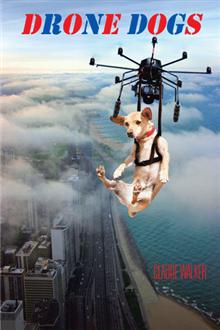
Author’s Notes
My first technology epiphany came on a starry night on the Appalachian Trail, 1974.
My buzzed college pals and I were careening down a thick mountain path, wildly swinging tree branches as we plummeted into a ravine. Maybe we were trying to find our inner mountain-man; I forget. Whooping, busting foliage, trampling whatever critters were trying to nest underfoot.
Wait. Stop. Just because I can swing a branch, doesn’t mean I should. Just because I can use this extension of my arm to destroy, doesn’t mean it’s OK.
As Congressman Tortuga notes in Drone Dogs, a debate over the appropriate use of technology has raged since Oog the Caveman opted not to bop Ugg on the head with a T-Rex bone. In the early 1800s, Luddites and mobs of textile workers smashed looms and other machines which threatened jobs, an understandable reaction to the Industrial Revolution.
The pace of change was never greater than in the past century, from Kitty Hawk and Model T’s to A-Bombs and social media. From smoky-industrial to icy-digital. Forty years ago, I could replace my carburetor; I wouldn’t try it now. The gap between how to make something and how to use it has grown, as has the gap between how to use something and how to use it with excellence.
Sadly, our ethics, behavior and laws have been outpaced by accelerated technological change fueled by narcissism. We’re reminded of Einstein’s observation that our “technology has exceeded our humanity”. But we’re also reminded of the Collingridge Dilemma: A new technology’s impact cannot be fully predicted until it is fully developed and used, but by then it’s too late to halt or change it.
In the 1970s, inspired by the growing green movement, energy crisis and words of economist E.F. Shumacher, an “appropriate technology movement” gelled. It urged renewable energy and “technology with a human face”. Congress created the Office of Technology Assessment (OTA) to provide independent analyses of potential economic, social and biological impacts of new technology. The OTA conducted 750 studies (before being cut in Newt’s “Contract with America”). Yet, the need for public participation in technological change has never been greater than now.
Another techno-epiphany came some years later. Day One of a vacation on a deserted Mexico island. Deserted except for a kid with a jet-ski from miles up-the-beach somewhere. Hour-after-hour, buzzing back-and-forth. Next day: same kid, same thing. Pitiless. The issue isn’t just that some technology is in the hands of the wrong people; it’s the brutally-obtrusive technology in the hands of idiots.
As a long-time subway rider, I’ve been subjected to “2nd-Hand Yak” of all kinds - shameless sexcapades, recitation of Social Security numbers, racist rants - and formed Walker’s Theorem: A direct correlation exists between the decibel level of a cellphone conversation and emptiness of the caller’s life.
And these are just the aural assaults. Now comes a new app to release aromas from a cellphone. A “Smellphone”, I guess. What could be bad about that?
At some point, commuters will rise up angry at unrelenting “2nd-Hand Yak” and demand electronics-free trains. Besieged beach-lovers will force resorts to ban jet-skis. Irked diners will insist that restaurants enforce no-cellphone policies. Sleepless residents will enact fines on planes which fly too low and car alarms which blast too high. Babies in strollers will beg parents to hang up the damn phone and talk to them. Families of victims killed by texting drivers will begin winning huge settlements.
As Big Drone’s power grows in Congress, City Hall and world capitals, a rapidly-growing fleet of private unmanned aerial vehicles will continue to congest our skies with few curbs.
Arguments will sound familiar. Drones create jobs. We’re just recreational hobbyists, collectors. Cutting the drone speed limit from 125-mph to 100-mph will delay delivery of your piping hot pizza; bad for small business. If I have a constitutional right to own a shotgun, why can’t I attach it to my drone? We can’t control what a private citizen does with one of our products, but offer condolences to the victims…
The result? More folks will blow them from the skies over their homes for sport, privacy or the tasty taco payload the drone is delivering. Drones will collide with jetliners, traffic-copters and more drones. Drones will crash into the Super Bowl, Thanksgiving Day Parade, Lollapalooza and the Statue of Liberty’s face. “Drone-peeping” will be popular with teen boys, tabloids, spies, sex creeps and Third World despots. Drones will disrupt energy and water systems. Assassination-by-drone is inevitable; coups, too.
Domestic drones are now in use for the public good: search-and-rescue, TV news, crop monitoring, infrastructure inspection, archaeology, oil spill detection, searching for pythons in the Everglades and Bigfoot in Canada. Drones will also be used by corporate and political oppo researchers, gang-bangers and taggers, terrorists, extortionists, dognappers and assorted idiots. Hence this tome.
Those who use technology best are those who use it appropriately and know when to hit the “Off” button.
Drone ya later!
Claude Walker, Chicago, 2015